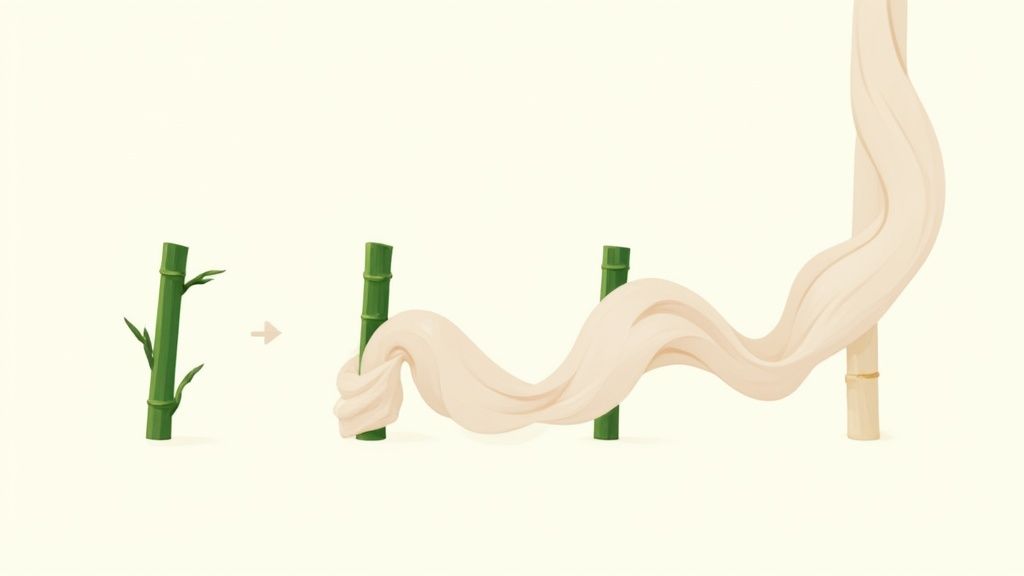
What Is Bamboo Viscose: Your Guide to This Silky Fabric
Share
Let's get straight to the point. Bamboo viscose is an incredibly soft, silky fabric that starts its life as a bamboo plant. It’s made by taking the tough, woody bamboo, breaking it down into a pulp, and then spinning that pulp into fine, delicate threads.
Those threads are then woven into the buttery-soft, drapey fabric you find in high-quality baby clothes.
So, What Is Bamboo Viscose Fabric?
Okay, but what does "viscose" actually mean? It’s not the plant itself, but the process used to turn that plant's tough cellulose fibers into a soft, wearable material.
Think of it like making a smoothie. You start with solid, fibrous ingredients (the bamboo stalks) and blend them down into a thick, smooth liquid (the viscous pulp). That pulp is then transformed into something completely new—in this case, fabric threads.
This method isn't just for bamboo; other plants like wood and even soy can be made into viscose. But when a label says "bamboo viscose," it means that the bamboo plant was the specific starting point for this amazing transformation. It's technically a type of rayon, which is the broader family name for fabrics made from regenerated cellulose.
From Stalk to Softness
The journey from a rigid plant to a gentle fabric is pretty fascinating. It all begins with harvesting mature bamboo, crushing it into a pulp, and then using a special chemical process to dissolve that pulp into a solution with a honey-like consistency.
This thick liquid is then forced through tiny holes—think of a showerhead, but much smaller—which is called a spinneret. This action creates fine filaments that solidify into the threads used for weaving.
Here’s a great visual that breaks down the main steps.
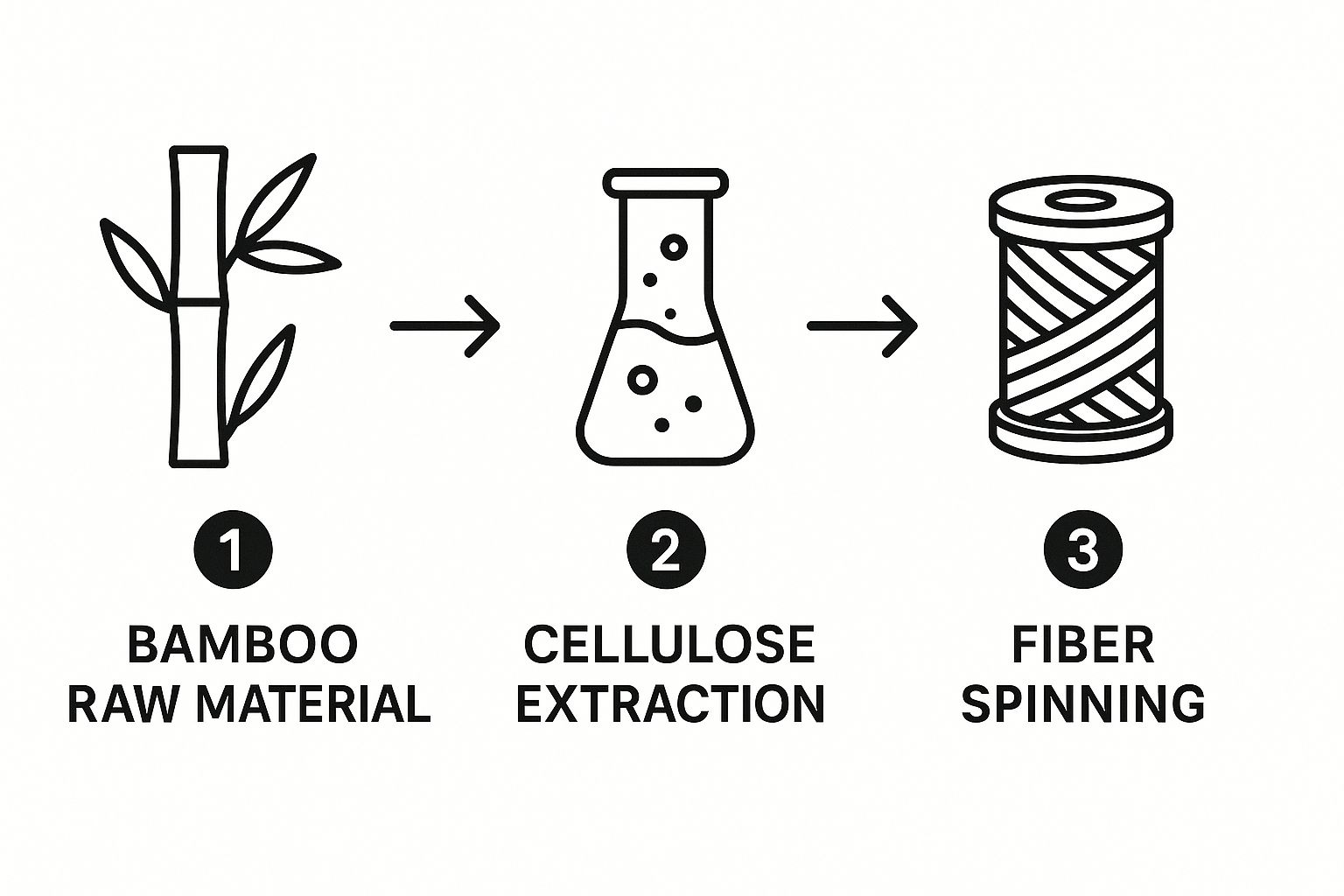
As you can see, the process fundamentally changes the bamboo from its original state. That’s why it’s called a "regenerated cellulose" fiber—it's man-made, but its source material is 100% natural.
To help you keep track of all the key features, here's a quick cheat sheet.
Bamboo Viscose at a Glance
| Characteristic | Description |
|---|---|
| Source Material | Made from the cellulose of bamboo plants. |
| Fabric Type | A type of rayon; a semi-synthetic, regenerated cellulose fiber. |
| Feel & Texture | Exceptionally soft, silky, and smooth with a luxurious drape. |
| Key Properties | Breathable, moisture-wicking, and hypoallergenic. |
| Common Uses | Popular for baby clothing, bedding, and activewear due to its comfort. |
This table sums it up nicely, showing why this fabric is so special.
At its heart, bamboo viscose is a clever blend of nature and science. It takes one of the planet's most renewable resources and uses a specific manufacturing method to unlock its potential for incredible softness and comfort.
This unique combination is what gives bamboo viscose all the qualities parents have come to adore, especially for a baby's delicate skin. It delivers a luxurious feel that's tough to beat, providing a gentle, soothing touch that’s just perfect for everything from sleepwear to daily outfits. Knowing this really helps explain why it's such a top-tier choice in children's wear.
How Tough Bamboo Becomes a Silky Soft Fabric
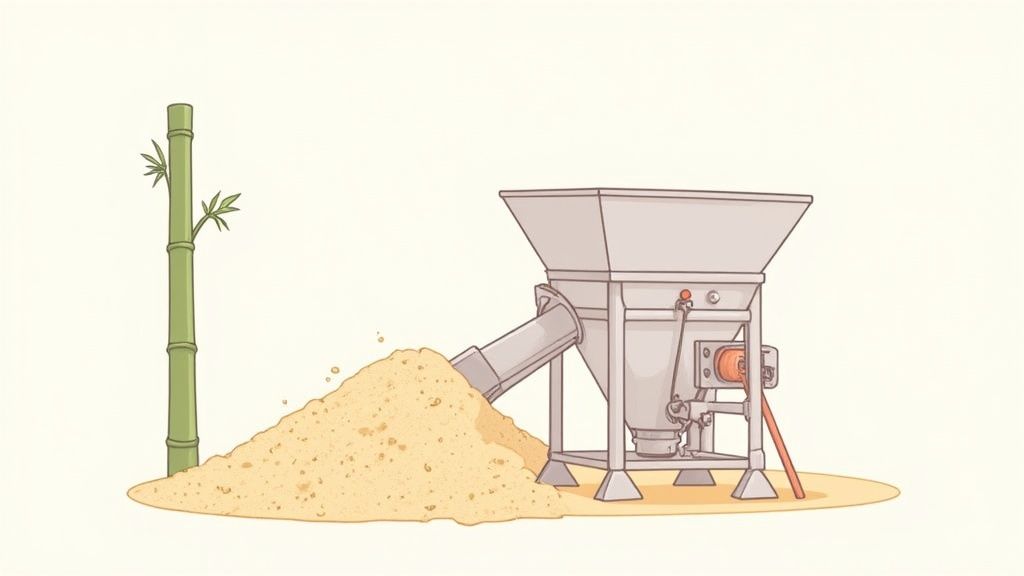
It’s one thing to hear that a hard, woody plant can be turned into a buttery-soft fabric, but how does that incredible transformation actually happen? The journey from a bamboo forest to your baby’s pajama drawer is a fascinating mix of natural materials and clever science.
Let's walk through this amazing process, broken down into four clear steps.
Step 1: Harvesting and Crushing the Bamboo
It all starts in sprawling bamboo groves. Workers harvest mature stalks—not the small decorative plants you might have at home, but giant species like Moso bamboo that can shoot up several feet in a single day.
Once harvested, these tough stalks are crushed and shredded into a raw, fibrous pulp. This first step is all about brute force, mechanically breaking down the rigid plant into a more manageable material. Think of it like turning a whole log into wood chips before making paper.
Step 2: Dissolving the Pulp into a Viscous Solution
This is where the real magic happens. The crushed bamboo pulp gets a bath in a sodium hydroxide solution. This chemical soak is what "melts" the bamboo, dissolving its natural cellulose while washing away everything else.
What’s left is a thick, sticky, honey-like liquid. This gooey substance is what gives "viscose" its name—it's literally a viscous solution of bamboo cellulose. This step is the key to turning solid plant matter into a liquid that can be shaped into fibers.
The transformation from solid pulp to liquid solution is the heart of the viscose process. It regenerates the natural cellulose from the bamboo plant into a new, pliable form, ready to be spun into thread.
Step 3: Spinning the Solution into Threads
Next, that purified bamboo goo is pumped through a device called a spinneret. Picture a showerhead, but with microscopic holes. As the liquid is forced through these tiny openings, it emerges as delicate filaments.
It's a lot like how a spider spins its web, extruding a liquid that solidifies into a strong thread. These newly formed filaments are then dipped into another chemical bath that hardens them into solid fibers, which can then be gathered up for the final stage.
This production method has actually been around since the early 1900s, but it's exploded in popularity as people look for soft, sustainable alternatives to older fabrics. Today, bamboo viscose makes up over 54.8% of the global bamboo fiber market.
Step 4: Weaving Threads into Fabric
Finally, those solidified fibers are washed, bleached, and spun into yarn. This yarn is now ready to be woven or knitted into the bamboo viscose fabric we all know and love for its incredible softness and silky drape.
From here, it's dyed and cut into patterns to create everything from luxurious baby pajamas to comfy adult loungewear.
While the process is definitely more involved than making fabrics like cotton, it’s exactly what gives bamboo viscose its signature feel. If you're curious how it stacks up against other popular materials, you should check out our guide comparing organic cotton vs. bamboo. This incredible transformation is what turns a famously tough plant into one of the gentlest fabrics you can put on your little one's skin.
Why Everyone Loves Bamboo Viscose Clothing
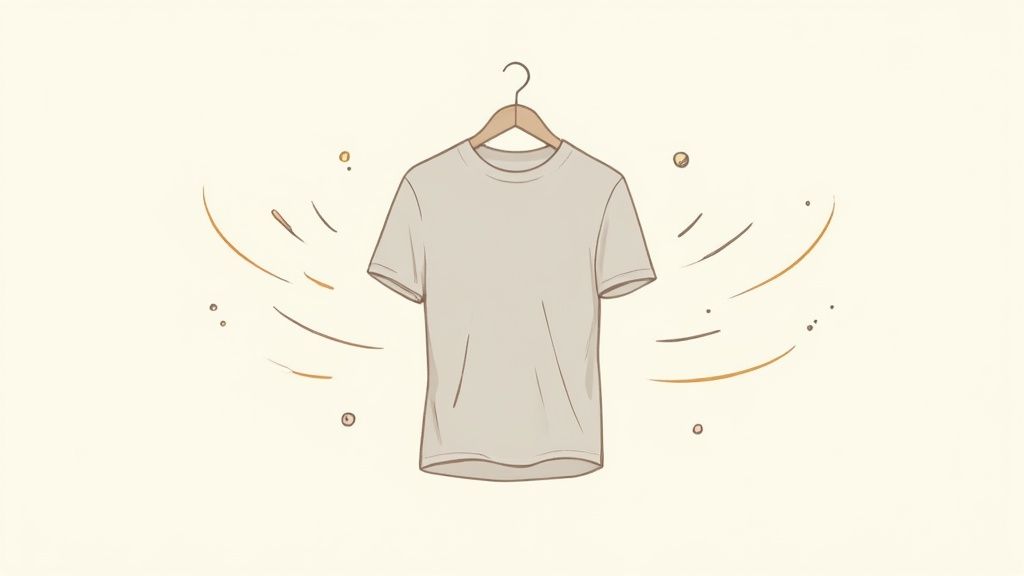
So, what’s all the fuss about bamboo viscose? It’s not just another tag on a onesie; it’s a whole different feeling. Once you touch it, you'll immediately get why parents are so obsessed with it for their little ones. The love for this fabric really boils down to a few key perks you can see and feel every single day.
The first thing that hits you is its unbelievable, cashmere-like softness. That’s not just marketing hype. Bamboo viscose has a silky, buttery texture that glides over the skin, making it absolutely perfect for a newborn’s delicate world.
This luxurious feel is a total game-changer, especially for babies who are a bit fussy about their clothes. It drapes gently instead of rubbing, which means less friction and a happier, more content baby, whether they're snoozing, playing, or snuggled up in your arms.
Designed for Ultimate Comfort
Beyond its amazing softness, bamboo viscose is a seriously high-performing fabric. It’s not just soft for the sake of it—it actively works to keep your little one comfortable. The unique structure of its fibers makes it incredibly breathable, letting air flow freely to prevent that dreaded overheating.
Paired with its breathability is another killer feature: it’s fantastic at wicking away moisture. The fabric literally pulls sweat and dampness away from the skin, allowing it to evaporate in a snap.
Think of it as nature's smart-wear for kids. Instead of trapping heat and sweat like some materials do, it helps regulate body temperature. This keeps them cool and dry when it's warm and comfortably cozy when it's cool. That thermo-regulating superpower translates to better sleep and much happier playtimes.
The real magic of bamboo viscose is how it combines a luxurious feel with practical, everyday performance. It delivers the softness you want with the breathability and gentle touch a child’s sensitive skin needs.
A Gentle Choice for Sensitive Skin
If you're a parent of a child with eczema or easily irritated skin, you know the struggle of finding the right clothes. So many fabrics just make things worse, causing redness and itchiness. This is where bamboo viscose truly shines—it’s widely loved for being hypoallergenic.
Its fibers are naturally smooth and round, so they don't have the scratchy, abrasive texture you might find in wool or even some rougher cottons. There’s less to "catch" on or aggravate delicate skin, which can mean fewer flare-ups and a much calmer, happier baby.
Here’s a quick rundown of why it's one of the best fabrics for sensitive skin:
- Silky Smooth Fibers: The surface is incredibly gentle and minimizes friction against the skin.
- Naturally Hypoallergenic: It’s less likely to harbor allergens that can trigger reactions.
- Moisture-Wicking: By keeping skin dry, it helps avoid the dampness that can make irritation even worse.
Choosing bamboo viscose is like wrapping your baby in a soft, protective hug. It’s a fabric that doesn’t just feel incredible—it actively helps promote healthier, happier skin. For parents, that means peace of mind, and for kids, it means pure, soothing comfort.
The Truth About Bamboo and Sustainability
When you see a tag that says "made from bamboo," it's easy to get a warm, fuzzy feeling about your purchase. We all know bamboo is an eco-superstar, and in many ways, that reputation is spot-on. But does that automatically make bamboo viscose an eco-friendly choice? The honest answer is... it's complicated.
The story begins with the plant itself, and this part is undeniably great. Bamboo is a true sustainability champion. As one of the fastest-growing plants on Earth, it shoots up with very little fuss.
It sips water, especially compared to a notoriously thirsty crop like conventional cotton, and it typically grows just fine without any pesticides or chemical fertilizers. Even better, it regenerates from its own roots, so there's no need to replant, which is fantastic for preventing soil erosion. From a pure, raw material perspective, bamboo is a hands-down winner.
The Manufacturing Reality
But the eco-story takes a sharp turn when we get to how that tough, woody plant becomes a silky-soft fabric. As we've covered, the viscose process relies on chemicals to break down the bamboo pulp. If those chemicals aren't handled with incredible care, they can cause real harm to the environment and the workers who handle them.
This is the make-or-break moment that separates a responsible brand from an irresponsible one. The sustainability of bamboo viscose isn't really about the plant—it's 100% about the production process.
A fabric's true environmental footprint is determined by how it's made, not just what it's made from. Responsible manufacturing is what turns a sustainable plant into a sustainable product.
This distinction is becoming more critical as people everywhere are looking for more eco-conscious textiles. With over 69% of the world's bamboo grown in the Asia-Pacific region, there's a huge push for manufacturers to adopt cleaner, more sustainable production methods to meet this growing demand.
What Is a Closed-Loop System?
So, how do the best manufacturers tackle this chemical problem? The answer is a clever process called a closed-loop system.
Picture a factory that recycles just about everything. In a closed-loop system, the chemicals and water used to dissolve the bamboo pulp aren't just used once and then dumped. Instead, they’re captured, purified, and reused again and again in a continuous cycle. This approach drastically cuts down on waste and stops harmful substances from ever reaching the outside world.
Yes, this method takes a bigger investment and more advanced technology, but it’s the gold standard for producing bamboo viscose responsibly. When you choose brands that work with closed-loop facilities, you're directly supporting a much cleaner, safer manufacturing process. For more on this, take a look at our guide to choosing chemical-free baby products.
At the end of the day, picking truly sustainable bamboo viscose means looking past the plant. It’s about asking the right questions and choosing to support brands that are committed to doing things the right way. By understanding what happens between the bamboo grove and the final fabric, you can make a choice that’s not only incredibly gentle on your baby’s skin but also much gentler on our planet.
How to Shop for and Care for Your Bamboo Viscose
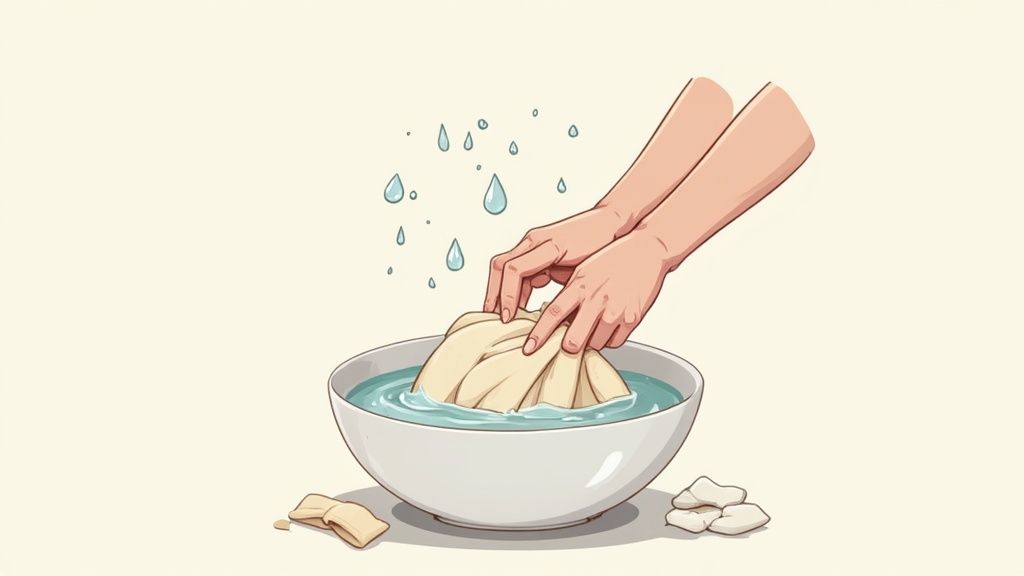
Alright, so you’re ready to wrap your little one in that buttery-soft bamboo goodness? Awesome choice. Knowing what to look for at checkout and how to treat these special items at home is the key to making them last.
A little savvy shopping and gentle handling will keep those PJs and onesies feeling brand new for a long, long time.
Finding Safe and Quality Bamboo Viscose
When you're shopping, the single most important thing to hunt for is a certification label. This little tag is your proof that the fabric is not only safe for your baby but also made with some integrity.
The gold standard here is the OEKO-TEX STANDARD 100 certification. Spotting this label means you can breathe easy. It’s a guarantee that every single part of the garment—we’re talking thread, fabric, buttons, everything—has been tested and found free of harmful chemicals.
Think of the OEKO-TEX label like a parent’s seal of approval. It’s the peace of mind you get knowing that what’s snuggled up against your baby's delicate skin is completely safe.
For any parent, but especially those with babies prone to irritation or eczema, this certification isn't just a "nice-to-have," it's a must-have. We dive deeper into why bamboo pajamas are a smart choice for babies with sensitive skin right here.
Simple Care for Long-Lasting Softness
Once you've got your beautiful bamboo viscose pieces home, keeping them in perfect condition is easier than you think. A little TLC is all it takes to maintain that incredible softness and prevent any unwanted shrinking.
The main takeaway? Be gentle and stay away from high heat.
Here’s the simple routine we swear by to keep our bamboo clothes feeling amazing:
- Wash on a Gentle Cycle: Stick with cold water and a mild detergent. The delicate or hand-wash setting on your machine is your best friend here.
- Skip the Fabric Softener: Honestly, you don’t need it! Bamboo viscose is already incredibly soft. Fabric softeners can also coat the fibers, which messes with their natural moisture-wicking magic.
- Dry on Low Heat (or None at All): If you use a dryer, always choose the lowest heat setting. Even better, hang the clothes or lay them flat to air dry. It's the kindest method and helps them last even longer.
Following these simple tips will make sure your baby gets to enjoy that cloud-like softness, wash after wash.
Still Have Questions About Bamboo Viscose?
Got a few questions still floating around? You're definitely not alone. When you’re digging into the details of a fabric like bamboo viscose, it’s natural to have a few things you want to clear up.
We’ve pulled together the most common questions we hear and answered them right here. The goal is to give you clear, straightforward info so you can feel totally confident about choosing this amazing material for your little one.
Is Bamboo Viscose the Same as 100% Bamboo Fabric?
This is a great question, and the short answer is: not exactly. The term "bamboo viscose" is all about how the fabric is made. It describes the specific process (the viscose process) that transforms bamboo pulp into the soft, silky fiber we know and love. It’s this manufacturing method that gives the fabric its signature feel.
You might occasionally stumble upon "bamboo linen," which is made using a more mechanical, hands-on process. But it’s pretty rare, more expensive, and feels a lot like traditional linen—not the buttery softness that makes bamboo viscose famous. So, whenever you find that incredibly soft bamboo clothing, you can bet it's bamboo viscose.
Think of it like this: "bamboo" is the ingredient, and "viscose" is the recipe. And that recipe is what turns a tough, woody plant into a silky-smooth textile perfect for your baby’s skin.
Does Bamboo Viscose Shrink in the Wash?
Like a lot of natural-based fibers, bamboo viscose can shrink a bit if it gets hit with high heat. This is exactly why following the care instructions on the tag is so important for keeping those favorite jammies in perfect shape.
To keep everything fitting just right, here’s what we recommend:
- Wash in cold water on a gentle or delicate cycle.
- Tumble dry on the lowest heat setting you’ve got, or even better, hang it up to air dry.
- Always give the garment’s care label a quick look for any specific instructions from the maker.
Many thoughtful brands also pre-shrink their fabric during production to help minimize this, so you'll usually find that any shrinkage is pretty minimal as long as you stick to these simple rules.
How Does Bamboo Viscose Compare to Cotton?
While both are fantastic choices for kids' clothes, they offer totally different experiences. The first thing you'll notice is the feel. Bamboo viscose is generally much softer and silkier than most cottons, with a beautiful, fluid drape that flows rather than stiffens.
When it comes to performance, bamboo viscose often comes out on top for moisture control. It's more absorbent and wicks moisture away from the skin faster, which is a game-changer for keeping little ones comfy and helping them regulate their body temperature. And while organic cotton is a great eco-friendly choice, the real sustainability of bamboo viscose all comes down to how a manufacturer produces it.
Why Is Bamboo Viscose Clothing More Expensive?
That slightly higher price tag usually boils down to the complex, multi-step process needed to create it. Turning a hard, woody plant into a luxurious fabric is just a more involved and resource-intensive journey than spinning raw cotton fibers straight into yarn.
Plus, when a brand commits to a more sustainable, closed-loop manufacturing system and earns certifications like OEKO-TEX, those responsible practices add to the cost. You’re not just paying for a softer fabric; you’re investing in a safer, more thoughtfully made product for your child and a gentler process for the planet.
At Little Venture Co., we believe in creating clothing that is as gentle on your little one's skin as it is on the earth. Explore our collection of OEKO-TEX certified bamboo viscose sleepwear and daywear, designed with comfort, safety, and inspiration in mind. Shop our faith-inspired children's wear today!
